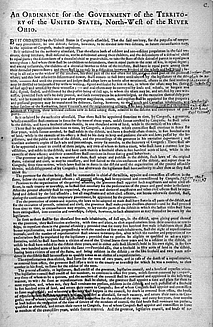The Northwest Ordinance
Northwest Ordinance
1787
-
The Northwest Ordinance, also known as “An Ordinance for the Government of the territory of the states, North-West of the River Ohio,” is a document written in 1784 and approved by the Confederation Congress in 1787 by a vote of 17-1. It provided the path toward statehood for the area that would become the states of Illinois, Indiana, Michigan, Ohio, Wisconsin, and part of Minnesota. These states are known as the Midwestern States today. The Northwest Ordinance allowed these states admission into the Union once it reached a certain population requirement. The Ordinace promised that slavery would be outlawed in the territories unless it served as punishment for a crime, education would be heavily encouraged, and good will toward Native Americans would be maintained. Section 8 of the document states: “For the prevention of crimes and injuries, the laws to be adopted or made shall have force in all parts of the district, and for the execution of process, criminal and civil, the governor shall make proper divisions thereof; and he shall proceed from time to time as circumstances may require, to lay out the parts of the district in which the Indian titles shall have been extinguished, into counties and townships, subject, however, to such alterations as may thereafter be made by the legislature.” This contradicts the document’s promise of goodwill towards Native Americans because it allows for a white governor to take Indigenous land.
